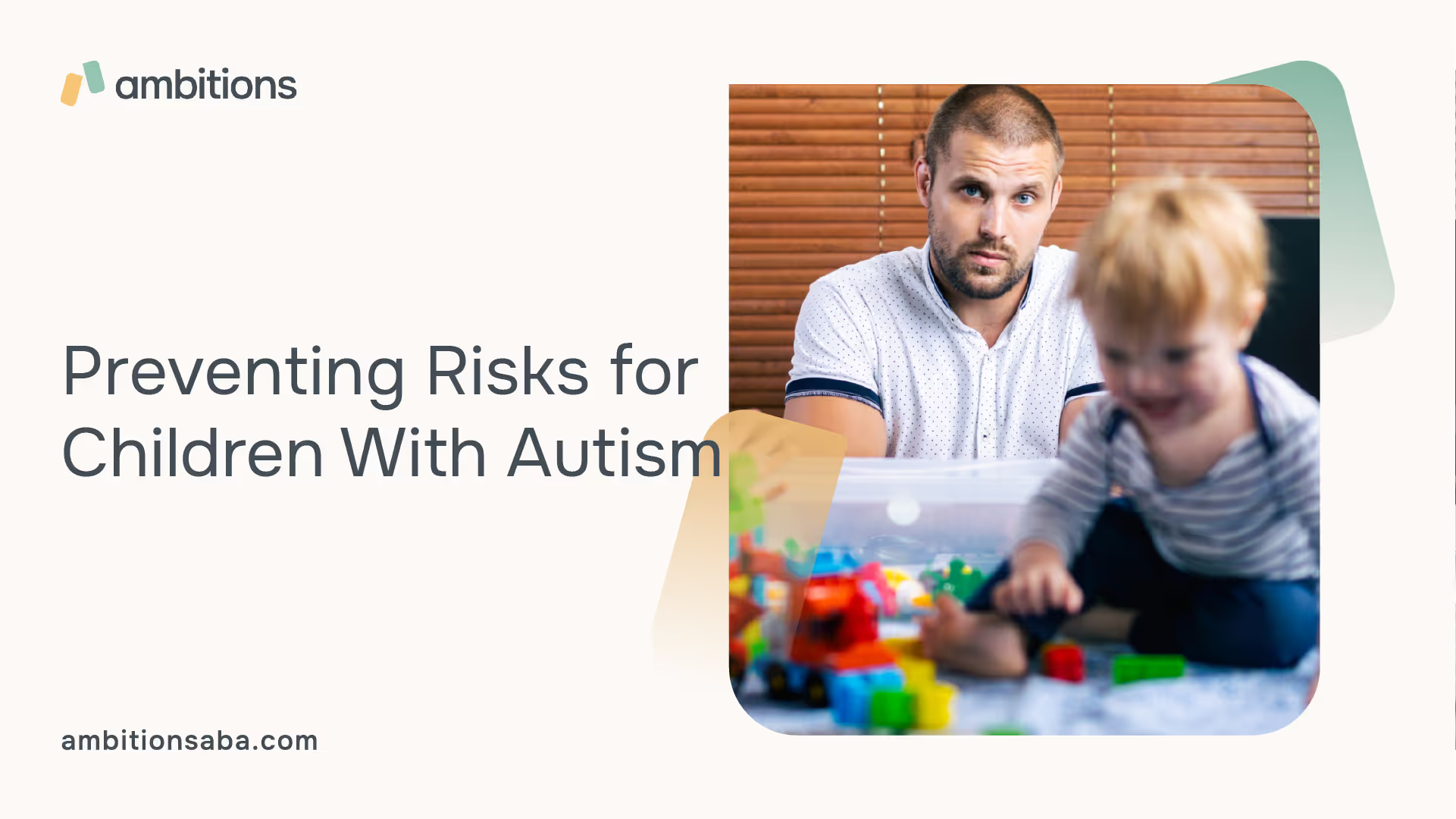Discover the truth about meat and autism. Learn how to maintain a balanced diet for overall health and well-being.
Understanding Autism and Safety
For parents of children with autism, ensuring their child's safety is of utmost importance. Understanding the impact of autism on safety and recognizing the vulnerabilities that children with autism may face is crucial in preventing risks and creating a secure environment.
Impact of Autism on Safety
Children with autism are more vulnerable and likely to place themselves in harm's way than neurotypical children, making safety a significant concern for parents and guardians. This vulnerability can vary based on the child's age, support needs, personality, and behaviors. It is estimated that approximately half of all children with autism attempt to elope or wander, even from their own homes, which can result in devastating consequences.

Sensory sensitivities, difficulties with communication, and challenges in social interactions further compound the risks faced by children with autism. These factors can contribute to behaviors such as elopement (running away), wandering, or engaging in repetitive or self-stimulatory actions that may put them at risk. It is important to recognize that each child's experience and behaviors may vary, necessitating customized safety strategies.
Vulnerabilities of Children with Autism
Parents of children with autism often experience emotional burden and distress. They worry about their child's safety and the long-term impact of autism on their future, including potential psychiatric comorbidities [4]. It is essential to provide support to parents and caregivers, acknowledging the challenges they face and ensuring they have access to resources and information to enhance their child's safety.
To effectively prevent risks and promote the safety of children with autism, parents and caregivers must be proactive in creating a safe environment and implementing appropriate safety measures. By understanding the impact of autism on safety and recognizing the vulnerabilities specific to their child, parents can take steps to ensure the well-being and security of their child.
In the following sections, we will explore strategies and safety measures that can help prevent wandering in autistic children, provide valuable insights on safety routines and skills, and discuss factors influencing the risk of autism. Additionally, we will delve into effective home safety tips and the utilization of safety products and tools to enhance the safety and well-being of children with autism.
Preventing Wandering in Autistic Children
Autistic children are more vulnerable and likely to place themselves in harm's way compared to neurotypical children, making safety a significant concern for parents and guardians. Wandering or elopement, which refers to the act of a child leaving a safe environment without supervision, is a common behavior observed in children with autism. It is crucial to implement preventive measures to ensure the safety of autistic children and minimize the risks associated with wandering.
Importance of Secure Environments
To prevent wandering in autistic children, it is crucial to create a secure environment both inside and outside the home. Half of all kids with autism wander and try to escape their own homes, resulting in devastating consequences. Here are some important steps to consider:
By creating a secure environment, you can significantly reduce the risk of wandering and ensure the safety of your child.
Identifying Triggers for Wandering
Identifying and understanding the triggers for a child's wandering behavior is essential in implementing effective safety measures to prevent wandering in autistic children. Each child may have unique triggers that lead to wandering, and recognizing these triggers can help in implementing appropriate preventive strategies. Here are some common triggers to be aware of:
By identifying the triggers that contribute to wandering, parents and caregivers can implement targeted strategies to prevent or redirect these behaviors. Working closely with professionals, such as behavioral therapists or autism specialists, can provide additional guidance and support in addressing wandering behaviors effectively.
Preventing wandering in autistic children requires a combination of creating secure environments and understanding individual triggers. By implementing these measures, parents and caregivers can help ensure the safety and well-being of their children with autism.
Safety Measures for Children with Autism
Ensuring the safety of children with autism is of utmost importance due to their unique vulnerabilities. Implementing specific safety measures can help mitigate potential risks and create a secure environment for these children. Two essential safety measures for children with autism include using weighted blankets and teaching safety routines and skills.
Using Weighted Blankets
Weighted blankets have been proven to help ease children with autism, providing an added feeling of security, especially at night [2]. These specialized blankets are designed to distribute gentle pressure evenly across the body, simulating the sensation of a comforting hug. The deep pressure touch provided by weighted blankets can have a calming effect and promote better sleep quality for children with autism.
Weighted blankets are available in various sizes and weights, and it's important to select the appropriate one based on the child's weight and preferences. It's also crucial to follow safety guidelines when using weighted blankets, ensuring that the child can easily remove the blanket if desired and that the blanket does not exceed a safe weight for the child's size.
Teaching Safety Routines and Skills
Establishing clear routines and teaching safety skills to children with autism is crucial for their well-being and protection. By teaching safety routines and skills, children with autism can learn how to navigate their surroundings and make informed decisions.
Some important safety routines and skills to teach children with autism include:
Visual supports, such as visual schedules, social stories, visual cues, and visual aids, are essential tools that assist individuals with autism in understanding and communicating information. These visual supports can be used to reinforce safety routines and skills, providing clear and easily understood instructions.
By incorporating weighted blankets and teaching safety routines and skills, parents and caregivers can enhance the safety and well-being of children with autism. These measures provide a sense of security and empower children to navigate their environment with confidence and reduced anxiety. Additionally, it is essential to work collaboratively with professionals, educators, and therapists to tailor safety strategies to the unique needs of each child with autism.
Factors Influencing Autism Risk
Understanding the factors that contribute to the risk of autism spectrum disorder (ASD) is essential for parents and caregivers. While the precise causes of ASD are still being researched, there are several genetic and environmental factors that have been identified as potential influencers.
Genetic and Environmental Factors
Research has shown that genetic factors play a significant role in the development of ASD. It is estimated that around 102 different genes may be involved in the chance of being born autistic. Having a family history of ASD, such as an autistic sibling, twin, or parent, increases the likelihood of being autistic as well.
In addition to genetic factors, environmental influences can also contribute to the risk of ASD. Studies have indicated an association between certain viral infections, metabolic imbalances, and the chance of being born autistic. Prenatal factors, including diet and intake of prenatal vitamins, particularly those containing vitamin D and folic acid, are crucial for the developing fetus.
Parental age is another factor that can impact the risk of having a child with ASD. Children born to older parents are at a greater risk of developing ASD. Furthermore, exposure to heavy metals and other environmental toxins during pregnancy has been suggested to raise the chance of being born autistic. Some prescription drugs used during pregnancy, such as valproic acid and certain selective serotonin reuptake inhibitors (SSRIs), have also been linked to ASD.
Understanding these factors can help parents and caregivers in taking proactive steps to mitigate risks and ensure the well-being of their children. While the specific causes of ASD may vary from one individual to another, being aware of these influences can contribute to early detection, intervention, and support for children with autism.
It's important to note that these factors do not guarantee the development of ASD, and many individuals with ASD do not have a clear identifiable cause. Researchers continue to explore the complex interplay between genetics and the environment to gain a deeper understanding of autism risk factors.
In the next section, we will explore safety measures and strategies that can help prevent risks and ensure the well-being of children with autism.
Enhancing Safety for Children with Autism
Ensuring the safety of children with autism is of utmost importance for parents and caregivers. By implementing effective home safety tips and utilizing appropriate safety products and tools, the risk of potential dangers can be significantly reduced.
Effective Home Safety Tips
Creating a safe environment within the home is essential for the well-being of children with autism. Here are some home safety tips to consider:
Utilizing Safety Products and Tools
Utilizing safety products and tools can provide an additional layer of protection for children with autism. Consider the following options:
It's important to remember that every child with autism is unique, and their safety needs may vary. Assess the specific requirements of your child and consult with professionals to determine the most effective safety measures for their well-being.
By implementing these home safety tips and utilizing appropriate safety products and tools, parents and caregivers can enhance the overall safety and security of children with autism, providing them with a nurturing environment to thrive in.
Supporting Parents and Caregivers
Raising a child with autism can present unique challenges and responsibilities for parents and caregivers. It is important to acknowledge and address the emotional burden they may experience, as well as recognize their crucial role in the success of their child's treatment.
Emotional Burden on Parents
Parents of children with autism often face significant emotional burdens. Studies have shown that mothers of children with autism spectrum disorder (ASD) may experience various forms of burden, including emotional burden, family burden, and social burden. They may feel overwhelmed, distressed, and vulnerable, and report elevated levels of anxiety, depression, and caregiving burden.
Concerns about the long-term impact of ASD on their child's future, including potential psychiatric comorbidities, are common among parents. It is crucial to provide support and resources to help parents navigate these emotional challenges and ensure their well-being.
Involvement in Treatment Success
Research has consistently shown that parental involvement in the treatment of children with autism is vital for successful outcomes. Parents can serve as effective interventionists and play a significant role in their child's progress. When parents are included in treatment, it improves the generalizability of skills and increases the amount of intervention the child receives.
The inclusion of parents in treatment has been found to be effective in reducing symptoms of ASD. Treatments that incorporate parent training components have shown successful outcomes. By actively involving parents in their child's therapy, parents become better equipped to support their child's development and extend the progress made during therapy into everyday life.
As parents and caregivers, it is essential to stay informed about the latest research and evidence-based interventions for autism. This knowledge empowers parents to make informed decisions and advocate for their child's needs effectively.
By recognizing and addressing the emotional burden on parents and involving them in their child's treatment, we can create a supportive environment that enhances the overall well-being and success of both the child and the entire family.
References
[2]: https://acornhealth.com/autism-information/15-home-safety-tips-for-children-with-autism/
[4]: https://www.ncbi.nlm.nih.gov/pmc/articles/PMC8001702/
[5]: https://www.healthline.com/health/autism-risk-factors
[7]: https://www.sciencedirect.com/science/article/abs/pii/S1077722911000745

